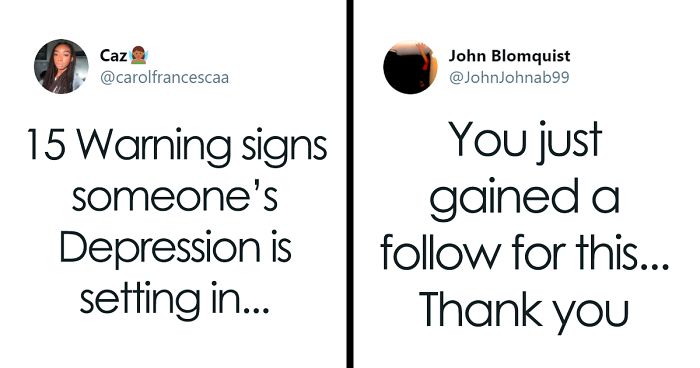
This Girl Shared A List Of 15 Warning Signs That Will Help You Recognize Someone Who Is Suffering From Depression
Depression is the most common mental disorder in the United States, affecting about 6.7% of the country’s population age 18 and older in a given year. According to the newest edition of The Diagnostic and Statistical Manual of Mental Disorders (also known as DSM-5), some of the main symptoms of depression include diminished interest or pleasure in almost all activities, slowing down of thought, reduction of physical movement, loss of energy, and feelings of worthlessness. A depressed person usually feels numb and isolated with a mind filled with all kinds of negative thoughts. And you can’t “snap out of it” or “look at things from a different perspective” because that’s not how mental disorders work.
One of the most common misunderstandings about depression is that this mental disorder is almost the same as sadness. And that’s absolutely not correct. Occasional sadness is an inevitable part of human existence. It visits us from time to time (usually after stressful or upsetting life events) and is a perfectly normal feeling that you sometimes simply can’t avoid. Though at times it might not feel like it, sadness can be a really valuable experience to a person, since it gives one some space to reflect and works as a reminder of what truly matters to them.
With depression, it’s a totally different thing. But the problem is, people tend to mix up these two words. A lot. In reality, these words refer to two absolutely different experiences. Depression is a serious mental disorder with long-lasting symptoms that can lead to serious health complications, including putting your own life at risk. Moreover, while sadness usually has a specific reason behind it, depressed individuals most of the time can’t even pinpoint the reason why they feel the way they do.
Another difficult thing about depression and other mental disorders as well is that they, a lot of the time, are pretty much invisible. A person struggling with depression from the outside can look perfectly normal. Despite that, if we’re paying enough attention to the ones around us, we can often tell if they’re not doing that great.
More info: Twitter
Recently, Twitter user carolfrancescaa shared an important thread of warning signs that can possibly tell us that a person is struggling with depression
Even though depression can have many faces, here are some of the signs we all should pay attention to
Caz suggests that people struggling with depression can become quieter than usual, seem more tired, can lose their appetite, start spending a lot of time alone, start avoiding eye contact, and not show genuine positive emotions.
Caz continues by adding that a depressed person can struggle to stay engaged in a conversation, become emotionally distant and apathetic, start experiencing big mood swings, and can seem to be avoiding making future plans.
Depressed individuals can also seem distracted, start talking less, and become much more irritable.
Caz ends her thread by emphasizing that you should definitely talk to a person and ask them how they’re doing if you notice any of these signs
Some Twitter users contributed by adding some more signs to the list
Some people shared their own experience living with this mental disorder
117Kviews
Share on FacebookI've struggled with depression and anxiety all my life and the worst part for me is, people say they care and whatnot but when I really need support I am alone. All the people I know don't understand and they really get annoyed with me and/or avoid me with "here we go again" attitudes. So, I stay away from people whether I'm in a good place or not, because I don't want to see that. For me figuring out how to truly be self sufficient and be my own cheerleader and not care about the fake 'friends' is what helps me stay strong. I have absolutely no faith in others to truly care about me. And on some level I guess I must be a pretty awful person to be around especially when I'm felling my worst...
Talk to your Dr/therapist about this. Group therapy with people who get you can do as much, and sometimes more, than the best meds
Load More Replies...Who else has trouble/ a fear of leaving the house? Ps most of the symptoms above especially the house being in total chaos
This is where some of us who are introverts have to be careful, it can cross a line. Usually when I get like this, I text friend or family and we schedule errands, meals and just getting together for a few days/weeks. I'm getting there again, and now is a very bad time for it. Also be aware that hoarding can also be a symptom of depression, which adds to chaos. I have to force myself to throw away the dumbest things and have a houseful of, for example, school supplies from when my daughter was in school. She graduated 2004.
Load More Replies...I JUST WANT YELL THANK YOU TO BP AND ALL COMMENTATORS!!!! I thought I was managing well til I read this article and the comments. I made an appointment with my Dr today. Apologies to anyone the following statement may offend, the sentiment is sincere. I thank Jehovah for all of you, you are gifts from him!
Good for you! "A journey of a thousand miles begins with a single step." Your journey will not be easy, and you will have setbacks, but never doubt that you are moving in the right direction.
Load More Replies...A very close family member is severely depressed. All the signs are there, he even talks about suicide. When you beg them to see a doctor or a therapist you hear "NO, I'm not crazy, only crazy people needs therapist". This has been going on for many years, and in the end just drives people away as you can't help someone that doesn't want to, completely refuses be helped. It'll end very badly, we all know that. It's a mental DISEASE, like any other, please don't be like this and seek help. There's nothing to be ashamed of, nothing to be guilty about, your can be the most privileged person in the world and still suffer from depression. Please allow a professional to help you.
The 'only crazy people see psychiatrists/therapists' attitude is a silent killer. It does seems to me that it's slowly going away. My generation (at least the people I know) seem to be much more comfortable with it than my father's and the generation younger than me seem to be more so. Lets hope it's a continuing trend.
Load More Replies...Also, depression sometimes make people think that nobody cares, or worse, that the world would be better off without them. https://m.youtube.com/watch?v=5gyANphz_Kk
For me, not so much nobody cares, I have ample and frequent evidence they do, but that I just don't matter. Which sounds the same as nobody cares, but it's not. It's the only way I can explain it
Load More Replies...I try not to judge the ones who leave. Frankly, if you are not capable of supporting or taking care of me when I'm in a depression, or if I get cancer or MS, etc., please have the grace to leave so that I can focus on taking care of myself and getting better. I've seen too many times where someone has stayed, "to help" and made things far worse, in one instance even endangering the loved one by taking her off her meds (anti-psychotics)"to give her body a break,"and becoming hysterical on a regular basis, which just added to the loved ones distress. The really difficult situations are where there is no one else to be with the one who is sick
Ladies and gentlemen, depression is a serious illness in our society. If your children are joking about having depression please stop them and explain to them why depression is a problem.
One thing that I wished got talked about more is that getting help can be hard. People get to the point where they're peeing in bottles instead of going to the bathroom because they're so depressed they can't move. Going online to find a doctor that suits you, leaving your house to go to an unfamiliar location that is inconveniently far away from bed, and talking to a person you've never met about very heavy and upsetting issues is overwhelming. Many people want help but can't get it. I wish people talked about this issue more.
For me it's the loss of purpose, like nothing matters anymore, there is no hope for me or for anyone, nothing brings me joy anymore. Plus I feel guilty af for what I've become. When the guilt and self-pity become unbearable, I rush to clean and take care of everything and everyone I neglected before, feeling mild satisfaction at most. Then this cycle repeats...
Mine are feeling like every limb weighs a ton. And my humor gets increasingly darker. I don't want to go anywhere. I get really quiet and get pissed if I feel I'm being pushed to talk. I feel generally empty.
I'd add over cleaning or being over clean too. I know I'm struggling when I'm bleaching everything in sight!
Talk to your doctor. There's a test/tests (brief) that you can take that helps them figure out what's going on with you. Good doctors will make sure you get access to a counselor as well as medication, if you need it. Good luck.
Load More Replies...Why do a lot of these describe me? I’m not depressed. I do sort of act like it sometimes, but like mom says, I’m a drama Queen.
I have experienced a lot of these things. Some other ones are: Being bored all the time but not wanting to do anything, No food looks or tastes as good, Everything is annoying or gets on my nerves, I don't want to be physically close to people, Hating pictures of myself or getting g a picture taken, Comforting myself with the fact that I might not live to have to deal with something
My parents don't believe in mental illnesses but I've completely lost all motivation for the things I've loved and struggle to get out of bed in the mornings. *cue harold hiding the pain face* But seriously, it sucks, my parents don't even believe depression is real, thus, I have no way to see a therapist to even try to get a diagonosis :(
I've had depression since I can remember. During this isolation, my depression and anxiety has worsened. I often feel like I'm going to have a full on panic attack. One thing that helps is to go for a walk or exercise. It really does help, and yes, I often have to just force myself. I miss being able to go out and be among people and socialize. The highlight of my week is to go out to the grocery store. I know there are a lot of people who have never had depression in their lives, who are now showing signs because of this isolation and the other stressors, like being jobless, lack of income, and inability to connect other than through social media. People who are still working are often putting in a lot of overtime and are getting burned out. I can only imagine what it is like to be a nurse or doctor at this time.
These may be examples but none of them reflect my symptoms. In fact, a lot of people with depression go to great lengths to not show their condition. Search for "16 Things People with depression want you to know". One of them is "We really try hard to look normal"! Please search and read this article and understand what we go through.
Another flag: People who do help/care may find that they are rebuffed, or assured it's "okay", b/c of stigmas about depression and so forth. Also beware the words, "I'll get to it!" if you ask them when they'll do (fill in blank). Those are ones I've seen, tho' not experienced myself in my dperessions. I just get into that abyss and hibernate like a wounded animal.
Some factors this person listed are right, but I wouldn't assume that this happens to everybody. From my experience, I had friends who are depressed that do distance themselves, but I have heard of other accounts of victims being peppy and outgoing despite their internal conflict. Some even get irritated when you offer your sympathies to them. In my opinion, this is the part where we don't understand and this is where we direct them to a therapist.
Pretty sure I have it. I've never been diagnosed and I can't afford to go to the doctors because I've been laid off now 3 times in 3 years. But reading around online and now reading this post, it's very clear to me that I do. I can't relate to a lot of these things listed. If you find yourself reading this and you've had depression or still do, what are some things you do to bring yourself to a good place? Do you keep a routine? Find accountability to make sure you show up? I go to the gym everyday and recently this year after my layoff switched times to the morning so I could be surrounded by people. Figured that would help. Interested to hear. Thank you if you respond!
Call a physician, or a mental health professional, and let them know your situation. Depending on where you live, they may be able to recommend low or no cost clinics in your area. You may have a small fee based on your current income, also they may be able to help you get meds at low or no cost
Load More Replies...The other thing that really sucks about depression, for me anyway, is I can be on a med that works great, but will gradually loose it's effectiveness over time. This happened to me recently and it was like a light bulb clicking on when I finally realized it. Talked to my doc, added a new med and became a brand new person. Another thing I struggle with is not knowing what 'normal' is. Am I adequately treating my disease or am I still struggling more than I should? It's so difficult to find the line between symptoms and the regular life kicking my a*s stuff that everyone experiences from time to time.
I have Asperger's syndrome, and most of these symptoms I have as well, and I definitely don't have depression. So this isn't a guaranteed list.
But is that your normal? From my experience with people with Aspergers some of these are common but just how they are, they don't change much over time. This list is more of a list of deviations from a persons normal that may indicate depression.
Load More Replies...The stigma of depression needs to go away. The stigma ruins lives more than the depression does it seems, in my experience. Thus... Most people don’t care. This virus makes all of it worse. It’s a lovely post. Depression is crippling. In my experience, I try to act “as if,” to make others comfortable - being cheerful, etc.
On the upside of being raised by crazy people, I now embrace it, I do not care what anyone else thinks of mental illness, which often draws people with mental illness to me and my daughter, they sense we don't see the difference. I don't worry if others are comfortable with me, but I do make effort to help then be comfortable with themselves and I educate myself as much as possible without actually going back to school. It takes work, I had to train myself not to care what others think, which by the way is freeing, so long as I am kind, compassionate and willing to gently educate when needed, and try not to judge the judgy (the most difficult).
Load More Replies...Her marriage ended because she was diagnosed bi-polar?? Sweet everlovin' Jesus. Life can be weird and crazy with a bi-polar person (my mom was), but once you're diagnosed and start getting treated life gets better and better. What an a*****e, honey, I hate to say it but it's probably better that someone who won't support you when you need him/her is gone.
Frankly, if you are not capable of properly handling and helping with what I'm going through, be it mental or physical illness, please leave, if possible. Having someone like that in your life at a time like that can make it oh, so much worse. See my comment elsewhere in this thread
Load More Replies...This is all true. The worst is when people get mad at me for emotions that are extremely hard to control with anxiety and depression. I need time alone and space to breath, not people bombarding me with "What's wrong?" and "Stop acting like that." Here's a thought: instead of judging me, just try to understand what I'm going through.
I don't think anyone has mentioned this but memory loss. Depression f***s with your ability to remember things.
When I can't don't have the energy to shower I used wet wipes on the "nooks and crannies". I keep them by the bed so I can freshen up a bit even if I can't get out of bed. Dry shampoo is useful too. What energy I have has to be used on household chores as I live alone. When you stack the washing up for days/weeks, don't stack it in the sink. That way you can wash the things that you need now without hassle (or having to do the whole lot)
I was going to say that I don't lose apetite because I tend to overeat when I'm at my worst. But it's not apetite at all, it's self-harm like any other. I eat with a vengeance, just as I harm myself in any other way. My depression is the reason I never want to get rid of my Maladaptive Daydreaming. It's saved me. It's also swallowed me, but it's saved me.
When I was seriously depressed I didn't realise I was depressed. All I knew was that nothing really seemed to matter any more, and that I just felt angry all the time. I was rude and hostile and basically chased everyone away. And I had this constant conviction that something terrible was going to happen - that my loved ones were going to turn on me, that I'd somehow get into big trouble (for what, I'm not really sure). Not that I had the energy to do anything about it. Mostly I just drank and watched the same TV shows over and over again. (Fortunately I eventually had the sense to get some therapy, and I'm so much better now).
The hardest part is knowing and not being able to fix it or stop it. I'm 35 and live back at home right now with my two young kids (5&6) and I will literally tell my mother when she will bring something up, like when the last time I showered was... Ewe... But I'll say I'll take one today, sorry I'm just in a really depressed state and time just kind of passes by, tell her that I'm just going through the motions and hiding anything unhappy from my kids as best I can. She brushes it off as if I've said nothing at all. A simple conversation once in a while with someone outside of the Peppa pig realm would probably do me a world of good lol. Anyway, that felt nice. Thanks.
In 1999, I was hospitalized with major depression. I worked right up to that day, interacted with customers and colleagues. No one knew what I was going through, not even my husband. My whole world was monochrome, no color, I was numb yet in great pain. All I wanted was for it to end. I spent the next 2 years in a fugue state, just trying to hold on. No matter what anyone told me I knew deep down that it was only a matter of time before I would die. From 1999 to now, I have had 2 great doctors help me find a way to survive. But I was still not thriving. Then in 2019, my doctor offered me another treatment, TMS. It has drastically changed my life. The change was subtle, but dramatic. I started treatments mid April and my last treatment was 25 July. I had a 35 minute treatment 5 days a week. My 43rd wedding anniversary was the 31st of July, my husband went into the hospital 6 Aug and died 12 Aug. I never would have made it through if I had not had the treatments.
In short any changes in their behaviour that are negative and not just for a day or two. I notice Risky Behaviour wasn't mentioned nor 'blurting' The other thing to look for is someone who has been depressed for quite some time who is suddenly more upbeat, happy even. It may be that they are planning suicide. For those who plan it in advance, the fact they know their pain will end feels like a relief to them. This is the most worrisome of all but is easily missed as we all want to see our loved ones feeling better..
I'm so glad, they all came together and spread awareness for depression signs :) Such wonderful people
The way I explain mental illness to people is: think of a diabetic, if their pancreas stops making the right amount of insulin, they will get sick and feel horrible. We would never judge a diabetic for using insulin. Someone with a mental illness often have a chemical imbalance that can be helped with a knowledgeable doctor and the correct medication. Some part of their body is not producing a chemical or using a chemical in the way it is supposed to, so taking a medication for your mental health is designed to get the correct chemical balance as close to it is supposed to be. So don't judge yourself or others if they need prescribed medication to feel better. Not self medicating with whatever, because that will just make it worse.
knowing how to recognise a drowning person, is VERY DIFFERENT to knowing how to HELP them. It's not that people "don't know how to recognise" someone in need... it's that they don't k now WHAT TO DO.
This is the same for so many people. I was actually in a ipsychiatric unit and I'm out and doesn't seem like it did any good. I think it's what you are born with, you try and try to feel different, but it just doesn't happpen.
I've been diagnosed with major depression a good 20 years ago, and I'm so glad these articles are being published, and that people are opening up about their own experience (s). Please look for people who start deliberately hurting themselves (i.e. cutting; I did that and no one noticed). It also felt like I was forced to walk under deep, dark water all the time as well
I relate with all of those signs but I haven't been diagnosed professionally so I don't think I can really say that I am struggling with depression and anxiety issues.
Maybe not "officially," but you know yourself best, you lived lived with yourself longer than any Dr. It's worth seeing about anytime you are not at optimum mental, emotional and physical health.
Load More Replies...I feel like I have depression? I mean, I fit most of these descriptions. But my parents probably wouldn't believe it. I don't blame them, they probably just wouldn't want to believe that their kid has depression. Should I talk to them? I don't know, am I just being overdramatic? I feel like I am. Plus, I wouldn't have it, I have a great life, no reason for me to be depressed, right?
Talk to them and or a dr / nurse who can guide you
Load More Replies...Why were you down voted? Trolls! Anyway, You may very well be. From my early twenties to mid forties, I was in an ongoing panic attack and didn't even realize until I began getting treatment for depression and low,thyroid, which resolved the panic. I still struggle with the depression. It can creep up on you, and you just assume it's normal until something like this article shows you it's not. Talk to your physician, because physical issues can cause depression. Shop and ask around for a good therapist. Be careful with alternative therapies, a lot of them work, but some, especially involving herbs, can be dangerous, especially when mixed with pharmaceutical meds. Be safe, and I hope it gets better
Load More Replies...The numbers on how many people suffer from depression are way too low. I'd say half of the people in this country are suffering from depression to various degrees right now. Nationwide, right now, what most of us are feeling are 1) Fear and 2) Anger. The political c**p, the feelings of helplessness, uncertainty about the future, anxiety about our health, jobs, money, or kids getting sick at school... You can't go anywhere, you can't do anything, you can't visit with friends or family.... We're feeling isolated when we need support from each other, feeling divided because of political turmoil, and sick at heart from racism. And don't think children don't feel it. They're suffering, too.
I’m a major introvert and most of this stuff isn’t introverted behavior..
Load More Replies...I've struggled with depression and anxiety all my life and the worst part for me is, people say they care and whatnot but when I really need support I am alone. All the people I know don't understand and they really get annoyed with me and/or avoid me with "here we go again" attitudes. So, I stay away from people whether I'm in a good place or not, because I don't want to see that. For me figuring out how to truly be self sufficient and be my own cheerleader and not care about the fake 'friends' is what helps me stay strong. I have absolutely no faith in others to truly care about me. And on some level I guess I must be a pretty awful person to be around especially when I'm felling my worst...
Talk to your Dr/therapist about this. Group therapy with people who get you can do as much, and sometimes more, than the best meds
Load More Replies...Who else has trouble/ a fear of leaving the house? Ps most of the symptoms above especially the house being in total chaos
This is where some of us who are introverts have to be careful, it can cross a line. Usually when I get like this, I text friend or family and we schedule errands, meals and just getting together for a few days/weeks. I'm getting there again, and now is a very bad time for it. Also be aware that hoarding can also be a symptom of depression, which adds to chaos. I have to force myself to throw away the dumbest things and have a houseful of, for example, school supplies from when my daughter was in school. She graduated 2004.
Load More Replies...I JUST WANT YELL THANK YOU TO BP AND ALL COMMENTATORS!!!! I thought I was managing well til I read this article and the comments. I made an appointment with my Dr today. Apologies to anyone the following statement may offend, the sentiment is sincere. I thank Jehovah for all of you, you are gifts from him!
Good for you! "A journey of a thousand miles begins with a single step." Your journey will not be easy, and you will have setbacks, but never doubt that you are moving in the right direction.
Load More Replies...A very close family member is severely depressed. All the signs are there, he even talks about suicide. When you beg them to see a doctor or a therapist you hear "NO, I'm not crazy, only crazy people needs therapist". This has been going on for many years, and in the end just drives people away as you can't help someone that doesn't want to, completely refuses be helped. It'll end very badly, we all know that. It's a mental DISEASE, like any other, please don't be like this and seek help. There's nothing to be ashamed of, nothing to be guilty about, your can be the most privileged person in the world and still suffer from depression. Please allow a professional to help you.
The 'only crazy people see psychiatrists/therapists' attitude is a silent killer. It does seems to me that it's slowly going away. My generation (at least the people I know) seem to be much more comfortable with it than my father's and the generation younger than me seem to be more so. Lets hope it's a continuing trend.
Load More Replies...Also, depression sometimes make people think that nobody cares, or worse, that the world would be better off without them. https://m.youtube.com/watch?v=5gyANphz_Kk
For me, not so much nobody cares, I have ample and frequent evidence they do, but that I just don't matter. Which sounds the same as nobody cares, but it's not. It's the only way I can explain it
Load More Replies...I try not to judge the ones who leave. Frankly, if you are not capable of supporting or taking care of me when I'm in a depression, or if I get cancer or MS, etc., please have the grace to leave so that I can focus on taking care of myself and getting better. I've seen too many times where someone has stayed, "to help" and made things far worse, in one instance even endangering the loved one by taking her off her meds (anti-psychotics)"to give her body a break,"and becoming hysterical on a regular basis, which just added to the loved ones distress. The really difficult situations are where there is no one else to be with the one who is sick
Ladies and gentlemen, depression is a serious illness in our society. If your children are joking about having depression please stop them and explain to them why depression is a problem.
One thing that I wished got talked about more is that getting help can be hard. People get to the point where they're peeing in bottles instead of going to the bathroom because they're so depressed they can't move. Going online to find a doctor that suits you, leaving your house to go to an unfamiliar location that is inconveniently far away from bed, and talking to a person you've never met about very heavy and upsetting issues is overwhelming. Many people want help but can't get it. I wish people talked about this issue more.
For me it's the loss of purpose, like nothing matters anymore, there is no hope for me or for anyone, nothing brings me joy anymore. Plus I feel guilty af for what I've become. When the guilt and self-pity become unbearable, I rush to clean and take care of everything and everyone I neglected before, feeling mild satisfaction at most. Then this cycle repeats...
Mine are feeling like every limb weighs a ton. And my humor gets increasingly darker. I don't want to go anywhere. I get really quiet and get pissed if I feel I'm being pushed to talk. I feel generally empty.
I'd add over cleaning or being over clean too. I know I'm struggling when I'm bleaching everything in sight!
Talk to your doctor. There's a test/tests (brief) that you can take that helps them figure out what's going on with you. Good doctors will make sure you get access to a counselor as well as medication, if you need it. Good luck.
Load More Replies...Why do a lot of these describe me? I’m not depressed. I do sort of act like it sometimes, but like mom says, I’m a drama Queen.
I have experienced a lot of these things. Some other ones are: Being bored all the time but not wanting to do anything, No food looks or tastes as good, Everything is annoying or gets on my nerves, I don't want to be physically close to people, Hating pictures of myself or getting g a picture taken, Comforting myself with the fact that I might not live to have to deal with something
My parents don't believe in mental illnesses but I've completely lost all motivation for the things I've loved and struggle to get out of bed in the mornings. *cue harold hiding the pain face* But seriously, it sucks, my parents don't even believe depression is real, thus, I have no way to see a therapist to even try to get a diagonosis :(
I've had depression since I can remember. During this isolation, my depression and anxiety has worsened. I often feel like I'm going to have a full on panic attack. One thing that helps is to go for a walk or exercise. It really does help, and yes, I often have to just force myself. I miss being able to go out and be among people and socialize. The highlight of my week is to go out to the grocery store. I know there are a lot of people who have never had depression in their lives, who are now showing signs because of this isolation and the other stressors, like being jobless, lack of income, and inability to connect other than through social media. People who are still working are often putting in a lot of overtime and are getting burned out. I can only imagine what it is like to be a nurse or doctor at this time.
These may be examples but none of them reflect my symptoms. In fact, a lot of people with depression go to great lengths to not show their condition. Search for "16 Things People with depression want you to know". One of them is "We really try hard to look normal"! Please search and read this article and understand what we go through.
Another flag: People who do help/care may find that they are rebuffed, or assured it's "okay", b/c of stigmas about depression and so forth. Also beware the words, "I'll get to it!" if you ask them when they'll do (fill in blank). Those are ones I've seen, tho' not experienced myself in my dperessions. I just get into that abyss and hibernate like a wounded animal.
Some factors this person listed are right, but I wouldn't assume that this happens to everybody. From my experience, I had friends who are depressed that do distance themselves, but I have heard of other accounts of victims being peppy and outgoing despite their internal conflict. Some even get irritated when you offer your sympathies to them. In my opinion, this is the part where we don't understand and this is where we direct them to a therapist.
Pretty sure I have it. I've never been diagnosed and I can't afford to go to the doctors because I've been laid off now 3 times in 3 years. But reading around online and now reading this post, it's very clear to me that I do. I can't relate to a lot of these things listed. If you find yourself reading this and you've had depression or still do, what are some things you do to bring yourself to a good place? Do you keep a routine? Find accountability to make sure you show up? I go to the gym everyday and recently this year after my layoff switched times to the morning so I could be surrounded by people. Figured that would help. Interested to hear. Thank you if you respond!
Call a physician, or a mental health professional, and let them know your situation. Depending on where you live, they may be able to recommend low or no cost clinics in your area. You may have a small fee based on your current income, also they may be able to help you get meds at low or no cost
Load More Replies...The other thing that really sucks about depression, for me anyway, is I can be on a med that works great, but will gradually loose it's effectiveness over time. This happened to me recently and it was like a light bulb clicking on when I finally realized it. Talked to my doc, added a new med and became a brand new person. Another thing I struggle with is not knowing what 'normal' is. Am I adequately treating my disease or am I still struggling more than I should? It's so difficult to find the line between symptoms and the regular life kicking my a*s stuff that everyone experiences from time to time.
I have Asperger's syndrome, and most of these symptoms I have as well, and I definitely don't have depression. So this isn't a guaranteed list.
But is that your normal? From my experience with people with Aspergers some of these are common but just how they are, they don't change much over time. This list is more of a list of deviations from a persons normal that may indicate depression.
Load More Replies...The stigma of depression needs to go away. The stigma ruins lives more than the depression does it seems, in my experience. Thus... Most people don’t care. This virus makes all of it worse. It’s a lovely post. Depression is crippling. In my experience, I try to act “as if,” to make others comfortable - being cheerful, etc.
On the upside of being raised by crazy people, I now embrace it, I do not care what anyone else thinks of mental illness, which often draws people with mental illness to me and my daughter, they sense we don't see the difference. I don't worry if others are comfortable with me, but I do make effort to help then be comfortable with themselves and I educate myself as much as possible without actually going back to school. It takes work, I had to train myself not to care what others think, which by the way is freeing, so long as I am kind, compassionate and willing to gently educate when needed, and try not to judge the judgy (the most difficult).
Load More Replies...Her marriage ended because she was diagnosed bi-polar?? Sweet everlovin' Jesus. Life can be weird and crazy with a bi-polar person (my mom was), but once you're diagnosed and start getting treated life gets better and better. What an a*****e, honey, I hate to say it but it's probably better that someone who won't support you when you need him/her is gone.
Frankly, if you are not capable of properly handling and helping with what I'm going through, be it mental or physical illness, please leave, if possible. Having someone like that in your life at a time like that can make it oh, so much worse. See my comment elsewhere in this thread
Load More Replies...This is all true. The worst is when people get mad at me for emotions that are extremely hard to control with anxiety and depression. I need time alone and space to breath, not people bombarding me with "What's wrong?" and "Stop acting like that." Here's a thought: instead of judging me, just try to understand what I'm going through.
I don't think anyone has mentioned this but memory loss. Depression f***s with your ability to remember things.
When I can't don't have the energy to shower I used wet wipes on the "nooks and crannies". I keep them by the bed so I can freshen up a bit even if I can't get out of bed. Dry shampoo is useful too. What energy I have has to be used on household chores as I live alone. When you stack the washing up for days/weeks, don't stack it in the sink. That way you can wash the things that you need now without hassle (or having to do the whole lot)
I was going to say that I don't lose apetite because I tend to overeat when I'm at my worst. But it's not apetite at all, it's self-harm like any other. I eat with a vengeance, just as I harm myself in any other way. My depression is the reason I never want to get rid of my Maladaptive Daydreaming. It's saved me. It's also swallowed me, but it's saved me.
When I was seriously depressed I didn't realise I was depressed. All I knew was that nothing really seemed to matter any more, and that I just felt angry all the time. I was rude and hostile and basically chased everyone away. And I had this constant conviction that something terrible was going to happen - that my loved ones were going to turn on me, that I'd somehow get into big trouble (for what, I'm not really sure). Not that I had the energy to do anything about it. Mostly I just drank and watched the same TV shows over and over again. (Fortunately I eventually had the sense to get some therapy, and I'm so much better now).
The hardest part is knowing and not being able to fix it or stop it. I'm 35 and live back at home right now with my two young kids (5&6) and I will literally tell my mother when she will bring something up, like when the last time I showered was... Ewe... But I'll say I'll take one today, sorry I'm just in a really depressed state and time just kind of passes by, tell her that I'm just going through the motions and hiding anything unhappy from my kids as best I can. She brushes it off as if I've said nothing at all. A simple conversation once in a while with someone outside of the Peppa pig realm would probably do me a world of good lol. Anyway, that felt nice. Thanks.
In 1999, I was hospitalized with major depression. I worked right up to that day, interacted with customers and colleagues. No one knew what I was going through, not even my husband. My whole world was monochrome, no color, I was numb yet in great pain. All I wanted was for it to end. I spent the next 2 years in a fugue state, just trying to hold on. No matter what anyone told me I knew deep down that it was only a matter of time before I would die. From 1999 to now, I have had 2 great doctors help me find a way to survive. But I was still not thriving. Then in 2019, my doctor offered me another treatment, TMS. It has drastically changed my life. The change was subtle, but dramatic. I started treatments mid April and my last treatment was 25 July. I had a 35 minute treatment 5 days a week. My 43rd wedding anniversary was the 31st of July, my husband went into the hospital 6 Aug and died 12 Aug. I never would have made it through if I had not had the treatments.
In short any changes in their behaviour that are negative and not just for a day or two. I notice Risky Behaviour wasn't mentioned nor 'blurting' The other thing to look for is someone who has been depressed for quite some time who is suddenly more upbeat, happy even. It may be that they are planning suicide. For those who plan it in advance, the fact they know their pain will end feels like a relief to them. This is the most worrisome of all but is easily missed as we all want to see our loved ones feeling better..
I'm so glad, they all came together and spread awareness for depression signs :) Such wonderful people
The way I explain mental illness to people is: think of a diabetic, if their pancreas stops making the right amount of insulin, they will get sick and feel horrible. We would never judge a diabetic for using insulin. Someone with a mental illness often have a chemical imbalance that can be helped with a knowledgeable doctor and the correct medication. Some part of their body is not producing a chemical or using a chemical in the way it is supposed to, so taking a medication for your mental health is designed to get the correct chemical balance as close to it is supposed to be. So don't judge yourself or others if they need prescribed medication to feel better. Not self medicating with whatever, because that will just make it worse.
knowing how to recognise a drowning person, is VERY DIFFERENT to knowing how to HELP them. It's not that people "don't know how to recognise" someone in need... it's that they don't k now WHAT TO DO.
This is the same for so many people. I was actually in a ipsychiatric unit and I'm out and doesn't seem like it did any good. I think it's what you are born with, you try and try to feel different, but it just doesn't happpen.
I've been diagnosed with major depression a good 20 years ago, and I'm so glad these articles are being published, and that people are opening up about their own experience (s). Please look for people who start deliberately hurting themselves (i.e. cutting; I did that and no one noticed). It also felt like I was forced to walk under deep, dark water all the time as well
I relate with all of those signs but I haven't been diagnosed professionally so I don't think I can really say that I am struggling with depression and anxiety issues.
Maybe not "officially," but you know yourself best, you lived lived with yourself longer than any Dr. It's worth seeing about anytime you are not at optimum mental, emotional and physical health.
Load More Replies...I feel like I have depression? I mean, I fit most of these descriptions. But my parents probably wouldn't believe it. I don't blame them, they probably just wouldn't want to believe that their kid has depression. Should I talk to them? I don't know, am I just being overdramatic? I feel like I am. Plus, I wouldn't have it, I have a great life, no reason for me to be depressed, right?
Talk to them and or a dr / nurse who can guide you
Load More Replies...Why were you down voted? Trolls! Anyway, You may very well be. From my early twenties to mid forties, I was in an ongoing panic attack and didn't even realize until I began getting treatment for depression and low,thyroid, which resolved the panic. I still struggle with the depression. It can creep up on you, and you just assume it's normal until something like this article shows you it's not. Talk to your physician, because physical issues can cause depression. Shop and ask around for a good therapist. Be careful with alternative therapies, a lot of them work, but some, especially involving herbs, can be dangerous, especially when mixed with pharmaceutical meds. Be safe, and I hope it gets better
Load More Replies...The numbers on how many people suffer from depression are way too low. I'd say half of the people in this country are suffering from depression to various degrees right now. Nationwide, right now, what most of us are feeling are 1) Fear and 2) Anger. The political c**p, the feelings of helplessness, uncertainty about the future, anxiety about our health, jobs, money, or kids getting sick at school... You can't go anywhere, you can't do anything, you can't visit with friends or family.... We're feeling isolated when we need support from each other, feeling divided because of political turmoil, and sick at heart from racism. And don't think children don't feel it. They're suffering, too.
I’m a major introvert and most of this stuff isn’t introverted behavior..
Load More Replies...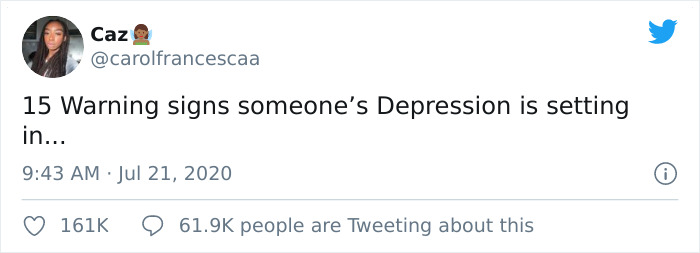
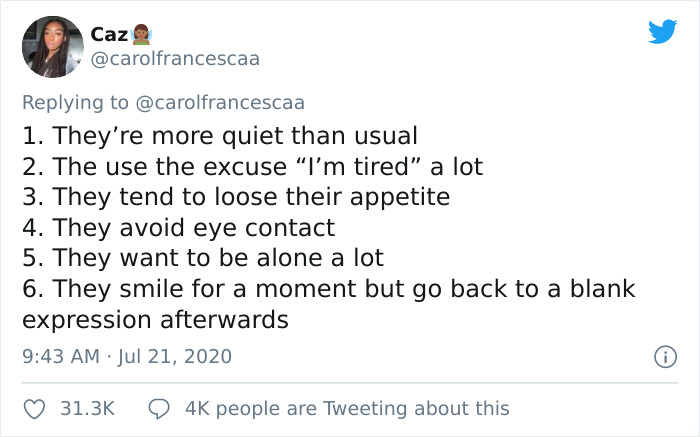
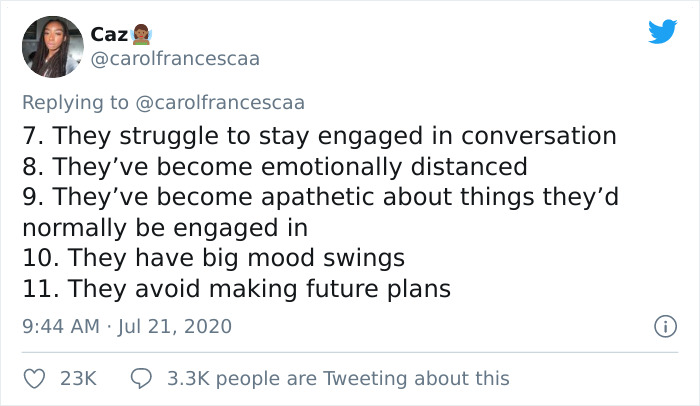
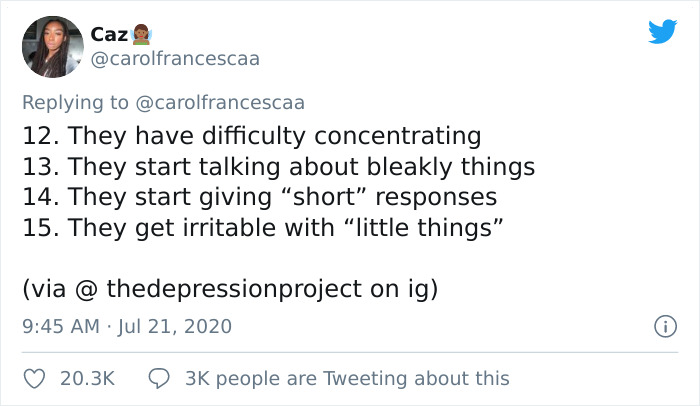
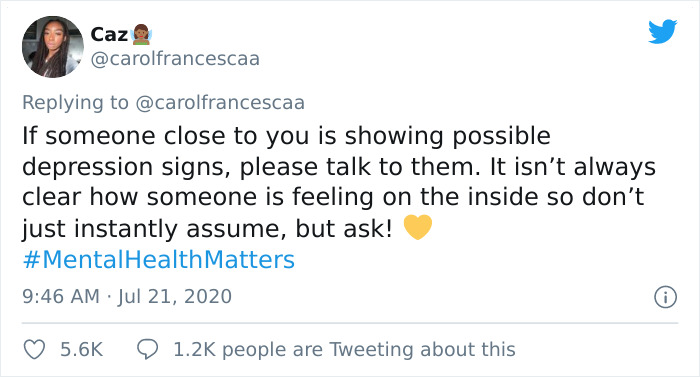
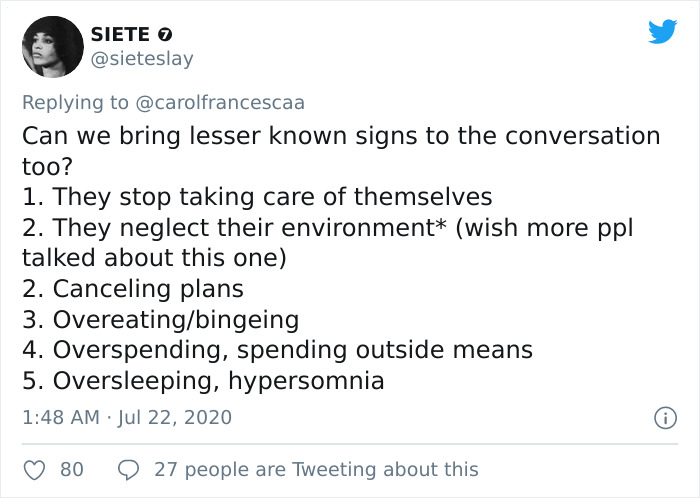
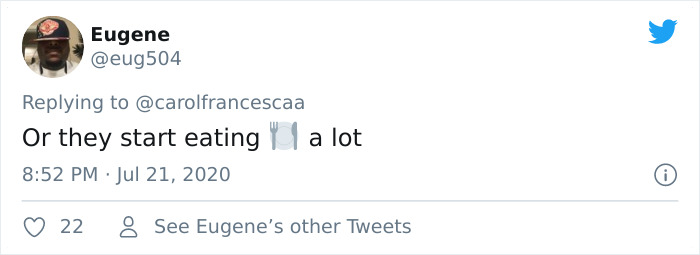

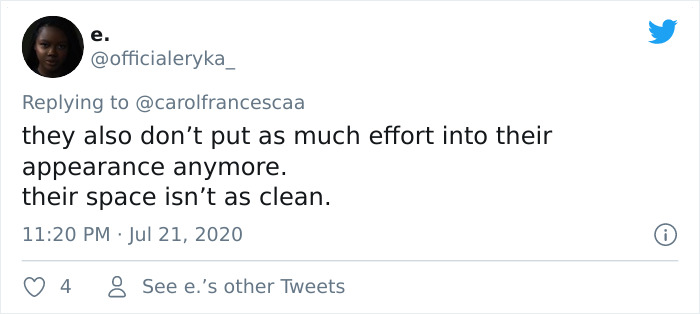
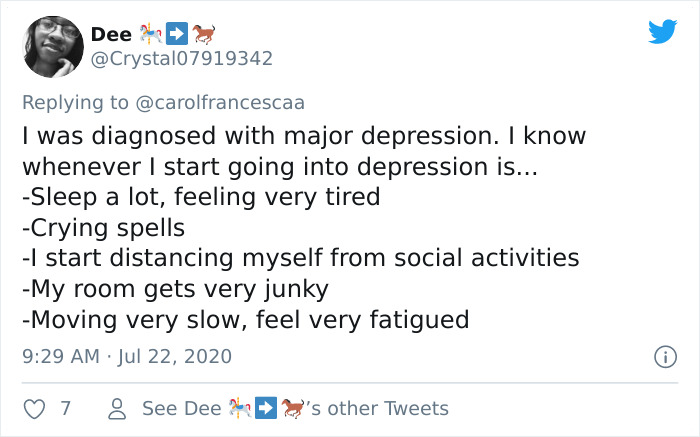
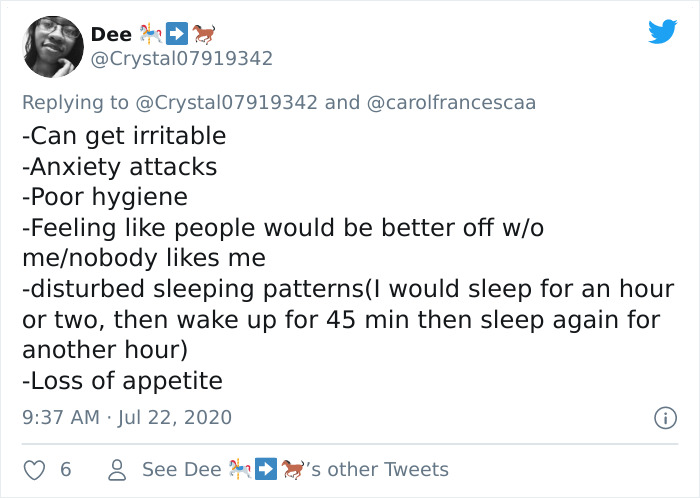
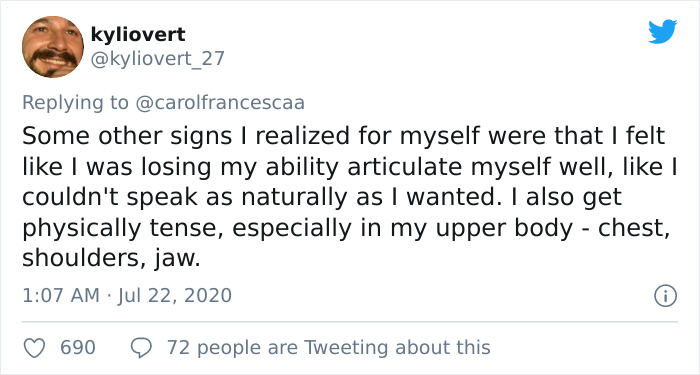
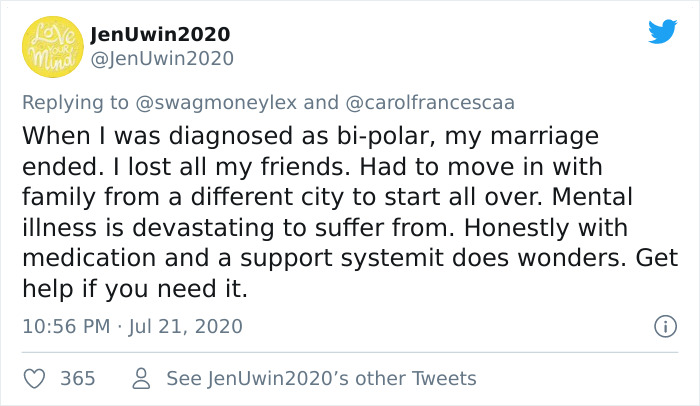
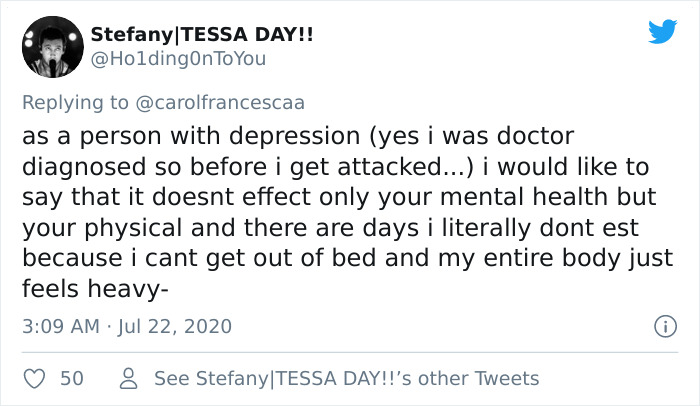
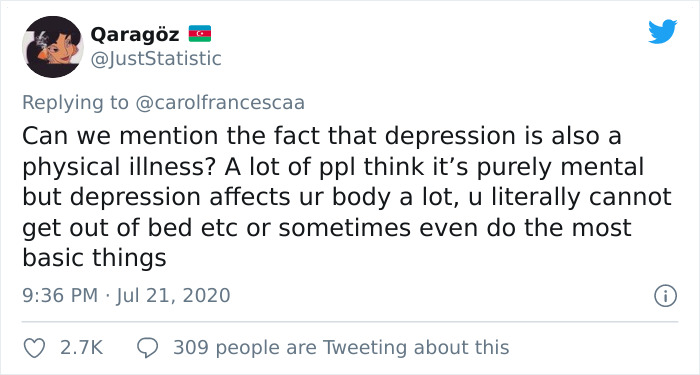
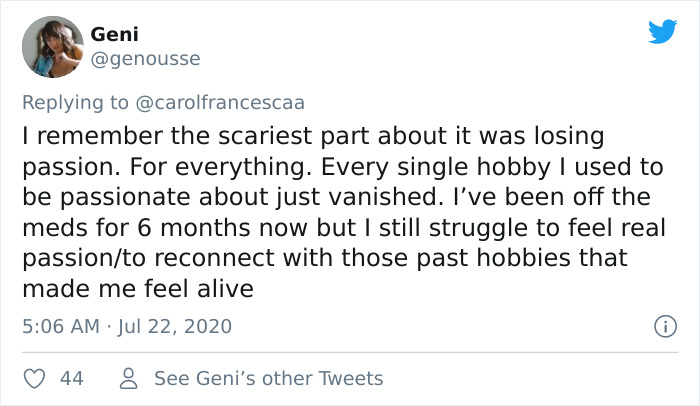
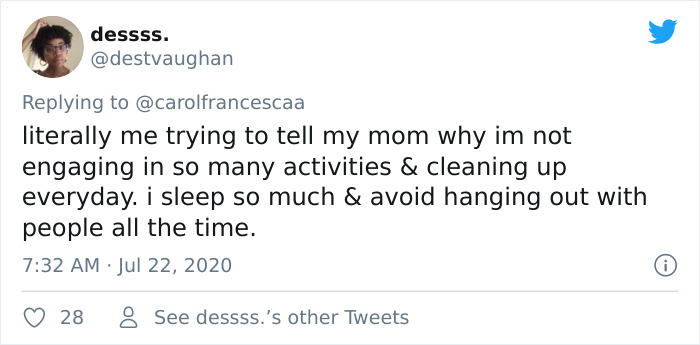
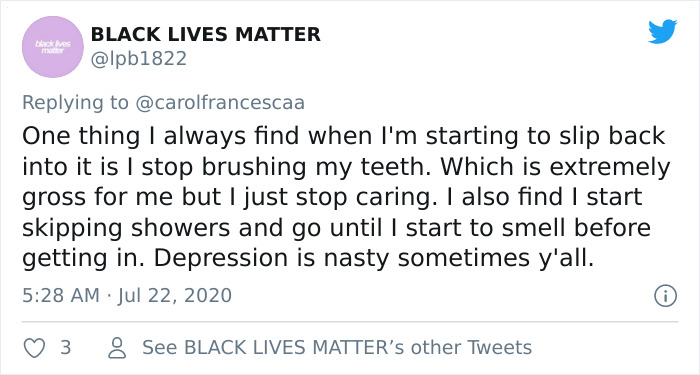



289
109